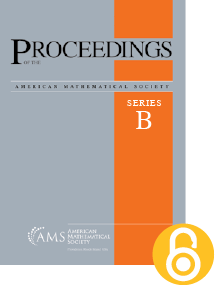Connecting a direct and a Galerkin approach to slow manifolds in infinite dimensions
HTML articles powered by AMS MathViewer
- by Maximilian Engel, Felix Hummel and Christian Kuehn HTML | PDF
- Proc. Amer. Math. Soc. Ser. B 8 (2021), 252-266
Abstract:
In this paper, we study slow manifolds for infinite-dimensional evolution equations. We compare two approaches: an abstract evolution equation framework and a finite-dimensional spectral Galerkin approximation. We prove that the slow manifolds constructed within each approach are asymptotically close under suitable conditions. The proof is based upon Lyapunov-Perron methods and a comparison of the local graphs for the slow manifolds in scales of Banach spaces. In summary, our main result allows us to change between different characterizations of slow invariant manifolds, depending upon the technical challenges posed by particular fast-slow systems.References
- Herbert Amann, Linear and quasilinear parabolic problems. Vol. I, Monographs in Mathematics, vol. 89, Birkhäuser Boston, Inc., Boston, MA, 1995. Abstract linear theory. MR 1345385, DOI 10.1007/978-3-0348-9221-6
- Peter W. Bates, Kening Lu, and Chongchun Zeng, Existence and persistence of invariant manifolds for semiflows in Banach space, Mem. Amer. Math. Soc. 135 (1998), no. 645, viii+129. MR 1445489, DOI 10.1090/memo/0645
- Maximilian Engel and Christian Kuehn, Blow-up analysis of fast-slow PDEs with loss of hyperbolicity, arXiv:2007.09973, pages 1–35, 2020.
- Neil Fenichel, Persistence and smoothness of invariant manifolds for flows, Indiana Univ. Math. J. 21 (1971/72), 193–226. MR 287106, DOI 10.1512/iumj.1971.21.21017
- Neil Fenichel, Geometric singular perturbation theory for ordinary differential equations, J. Differential Equations 31 (1979), no. 1, 53–98. MR 524817, DOI 10.1016/0022-0396(79)90152-9
- Felix Hummel and Christian Kuehn, Slow manifolds for infinite-dimensional evolution equations, arXiv:2008.10700, pages 1–53, 2020.
- Christopher K. R. T. Jones, Geometric singular perturbation theory, Dynamical systems (Montecatini Terme, 1994) Lecture Notes in Math., vol. 1609, Springer, Berlin, 1995, pp. 44–118. MR 1374108, DOI 10.1007/BFb0095239
- Govind Menon and György Haller, Infinite dimensional geometric singular perturbation theory for the Maxwell-Bloch equations, SIAM J. Math. Anal. 33 (2001), no. 2, 315–346. MR 1857973, DOI 10.1137/S0036141000360458
- Stephen Wiggins, Normally hyperbolic invariant manifolds in dynamical systems, Applied Mathematical Sciences, vol. 105, Springer-Verlag, New York, 1994. With the assistance of György Haller and Igor Mezić. MR 1278264, DOI 10.1007/978-1-4612-4312-0
- Jean-Christophe Yoccoz, An introduction to small divisors problems, From number theory to physics (Les Houches, 1989) Springer, Berlin, 1992, pp. 659–679. MR 1221113
Additional Information
- Maximilian Engel
- Affiliation: Department of Mathematics and Computer Science, Freie Universität Berlin, Arnimallee 6, 14195 Berlin, Germany
- MR Author ID: 1217727
- ORCID: 0000-0002-1406-8052
- Email: maximilian.engel@fu-berlin.de
- Felix Hummel
- Affiliation: Faculty of Mathematics, Technical University of Munich, Boltzmannstraße 3, 85748 Garching bei München, Germany
- MR Author ID: 1319692
- ORCID: 0000-0002-2374-7030
- Email: hummel@ma.tum.de
- Christian Kuehn
- Affiliation: Faculty of Mathematics, Technical University of Munich, Boltzmannstraße 3, 85748 Garching bei München, Germany
- MR Author ID: 875693
- ORCID: 0000-0002-7063-6173
- Email: ckuehn@ma.tum.de
- Received by editor(s): March 1, 2021
- Published electronically: August 19, 2021
- Additional Notes: The first author was supported by Germany’s Excellence Strategy – The Berlin Mathematics Research Center MATH+ (EXC-2046/1, project ID: 390685689).
The second author acknowledges partial support via the SFB/TR109 “Discretization in Geometry and Dynamics” as well as partial support of the EU within the TiPES project funded the European Unions Horizon 2020 research and innovation programme under grant agreement No. 820970.
The third author acknowledges support via a Lichtenberg Professorship as well as support via the SFB/TR109 “Discretization in Geometry and Dynamics” as well as partial support of the EU within the TiPES project funded the European Unions Horizon 2020 research and innovation programme un der grant agreement No. 820970.
This project is TiPES contribution #80: This project had received funding from the European Union’s Horizon 2020 research and innovation programme under grant agreement No 820970
The authors gratefully acknowledge the financial support of the TUM publishing fund for an open access publication of this article - Communicated by: Wenxian Shen
- © Copyright 2021 by the authors under Creative Commons Attribution 3.0 License (CC BY 3.0)
- Journal: Proc. Amer. Math. Soc. Ser. B 8 (2021), 252-266
- MSC (2020): Primary 37L15, 37L25, 37L65; Secondary 34E15, 35K57
- DOI: https://doi.org/10.1090/bproc/92
- MathSciNet review: 4302153


